Extremes on Earth
This article describes extreme locations on Earth. Entries listed in bold are Earth-wide extremes.
Extreme global temperatures
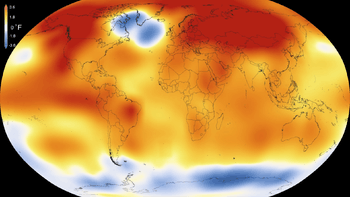
Extreme elevations and air temperatures per continent
| Continent | Elevation (height above/below sea level)A | Air Temperature (recorded)[2]B | |||
| Highest | Lowest | Highest | Lowest | ||
| Africa | 5,893 m (19,334 feet) Kilimanjaro, Tanzania[3] | −155 m (−509 feet) Lake Assal, Djibouti[4] | 55 °C (131 °F) Kebili, French Tunisia 7 July 1931C | −23.9 °C (−11.0 °F) Ifrane, French Morocco 11 February 1935 | |
| Antarctica | 4,892 m (16,050 feet) Vinson Massif[5] | 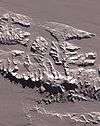 | −50 m (−164 feet)[6] Deep Lake, Vestfold Hills (compare the deepest ice section below) | 20.75 °C (69.35 °F) Comandante Ferraz Antarctic Station 9 February 2020 | −89.2 °C (−128.6 °F) Vostok Station 21 July 1983 |
| Asia | 8,848 m (29,029 feet) Mount Everest, China-Nepal Border [7] | 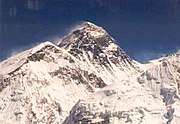 | −424 m (−1,391 feet) Dead Sea, Israel-Jordan-Palestine[8] | 54 °C (129 °F) Tirat Zvi, Israel (then in the British Mandate of Palestine) 21 June 1942 | −67.7 °C (−89.9 °F) Measured Oymyakon, Siberia, Soviet Union 6 February 1933[9][10] |
| 54 °C (129 °F) Ahvaz Airport, Iran 29 June 2017[11] |
−71.2 °C (−96.2 °F) Extrapolated Oymyakon, Siberia, Soviet Union 26 January 1926[12] | ||||
| Europe | 5,642 m (18,510 feet) Mount Elbrus, Russian Federation[13] |  | −28 m (−92 feet) Caspian Sea shore, Russian Federation[14] | 48.0 °C (118.4 °F) Athens, Greece (and Elefsina, Greece) 10 July 1977 E | −58.1 °C (−72.6 °F) Ust-Shchuger, Soviet Union 31 December 1978 |
| North America | 6,190.5 m (20,310 feet) Denali (Mount McKinley), Alaska, United States[15] |  | −85 m (−279 feet) Badwater Basin, California, United States[16] | 56.7 °C (134 °F) Greenland Ranch (Furnace Creek), California, United States 10 July 1913C | −66.1 °C (−87.0 °F) North Ice, Greenland 9 January 1954F |
| Oceania | 4,884 m (16,024 feet) Puncak Jaya (Carstensz Pyramid), Indonesia (compare Mount Wilhelm, Mount Cook and Mount Kosciuszko)[17] | 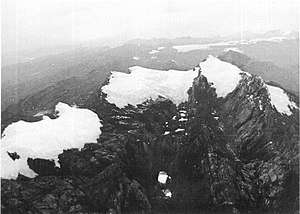 | −15 m (−49 feet) Lake Eyre, South Australia, Australia[18] | 50.7 °C (123.3 °F) Oodnadatta, South Australia, Australia 2 January 1960G | −25.6 °C (−14.1 °F) Ranfurly, Otago, New Zealand 17 July 1903 |
| South America | 6,962 m (22,841 feet) Aconcagua, Mendoza, Argentina[19] |  | −105 m (−344 feet) Laguna del Carbón, Argentina[20] | 48.9 °C (120.0 °F) Rivadavia, Salta Province, Argentina 11 December 1905 | −32.8 °C (−27.0 °F) Sarmiento, Chubut Province, Argentina 1 June 1907 |
| |||||
Coldest and hottest inhabited places on Earth
| Hottest inhabited place | Dallol, Ethiopia (Amharic: ዳሎል), whose annual mean temperature was recorded from 1960 to 1966 as 34.4 °C (93.9 °F).[26] The average daily maximum temperature during the same period was 41.1 °C (106.0 °F).[27] |
| Coldest inhabited place | Oymyakon (Russian: Оймяко́н), a rural locality (selo) in Oymyakonsky District of the Sakha Republic, the Russian Federation, has the coldest monthly mean, with −46.4 °C (−51.5 °F) the average temperature in January, the coldest month. Eureka, Nunavut, Canada has the lowest annual mean temperature at −19.7 °C (−3.5 °F).[28] |
| The South Pole and some other places in Antarctica are colder and are populated year-round, but almost everyone stays less than a year and could be considered visitors, not inhabitants. |
Extreme ground temperatures
Temperatures measured directly on the ground may exceed air temperatures by 30 to 50 °C.[29] A ground temperature of 84 °C (183.2 °F) has been recorded in Port Sudan, Sudan.[30] A ground temperature of 93.9 °C (201 °F) was recorded in Furnace Creek, Death Valley, California, United States on 15 July 1972; this may be the highest natural ground surface temperature ever recorded.[31] The theoretical maximum possible ground surface temperature has been estimated to be between 90 and 100 °C for dry, darkish soils of low thermal conductivity.[32]
Satellite measurements of ground temperature taken between 2003 and 2009, taken with the MODIS infrared spectroradiometer on the Aqua satellite, found a maximum temperature of 70.7 °C (159.3 °F), which was recorded in 2005 in the Lut Desert, Iran. The Lut Desert was also found to have the highest maximum temperature in 5 of the 7 years measured (2004, 2005, 2006, 2007 and 2009). These measurements reflect averages over a large region and so are lower than the maximum point surface temperature.[29]
Satellite measurements of the surface temperature of Antarctica, taken between 1982 and 2013, found a coldest temperature of −93.2 °C (−136 °F) on 10 August 2010, at 81.8°S 59.3°E. Although this is not comparable to an air temperature, it is believed that the air temperature at this location would have been lower than the official record lowest air temperature of −89.2 °C.[33][34]
Greatest vertical drop
| Greatest purely vertical drop | 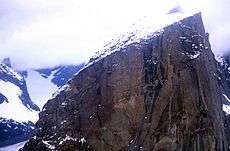 Mount Thor, Auyuittuq National Park, Baffin Island, Nunavut, Canada (summit elevation 1,675 m (5,495 ft))[35][36] |
| Greatest nearly vertical drop | 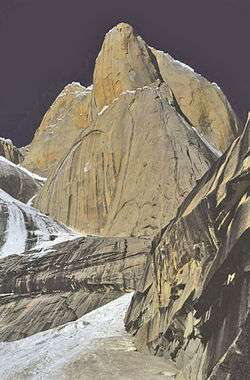 Trango Towers, Gilgit-Baltistan, Pakistan (summit elevation 6,286 m (20,623 ft)) |
Subterranean
| Deepest mine below ground level | 4,000 m (13,123 ft) Mponeng Gold Mine, Gauteng Province, South Africa |
| Deepest mine below sea level | 2,733 m (8,967 ft) below sea level Kidd Mine, Ontario, Canada |
| Deepest open-pit mine below ground level | 1,200 m (3,937 ft) Bingham Canyon Mine, Utah, United States |
| Deepest open-pit mine below sea level | 293 m (961 ft) below sea level Tagebau Hambach, Germany |
| Deepest cave (measured from the entrance) | 2,204 m (7,231 ft) Veryovkina, Arabika Massif, Abkhazia, Georgia [37] |
| Deepest pitch (single vertical drop) | 1,026 m (3,366 ft) Tian Xing Cave, China[38] |
| Deepest borehole | 12,261 m (40,226 ft) Kola Superdeep Borehole, Russia[39] |
Greatest oceanic depths
| Atlantic Ocean | 8,376 m (27,480 ft)[40] Milwaukee Deep (also known as Brownson Deep), Puerto Rico Trench |
| Arctic Ocean | 5,550 m (18,209 ft)[41] Molloy Deep, Fram Strait |
| Indian Ocean | 7,192 m (23,596 ft)[42] Sunda Trench |
| Mediterranean Sea | 5,267 m (17,280 ft) Calypso Deep, Hellenic Trench |
| Pacific Ocean | 10,928 m (35,853 ft)[43] Challenger Deep, Mariana Trench[44] |
| Southern Ocean | 7,433.6 m (24,388 ft)[45] South Sandwich Trench (southernmost portion, at 60°28.46′S 025°32.32′W) |
Deepest ice
Ice sheets on land, but having the base below sea level. Places under ice are not considered to be on land.
| Bentley Subglacial Trench | −2,555 m (−8,383 ft) | Antarctica |
| Trough beneath Jakobshavn Isbræ | −1,512 m (−4,961 ft)[46] | Greenland, Denmark |
Northern and southernmost points of land on Earth
| Northernmost point on land | Kaffeklubben Island, east of Greenland (83°40′N 29°50′W) Various shifting gravel bars lie further north, the most famous being Oodaaq |
| Southernmost point on land | The geographic South Pole |
| Southernmost continental point of land outside Antarctica | Cape Froward (Spanish: Cabo Froward) (53°56′00″S 071°20′00″W), Magallanes Region, Chile |
The Gould Coast (Coordinates: 84°30′S 150°0′W)[47] is the southernmost point of ocean while the southernmost open sea is nearby Bay of Whales at 78°30'S, at the edge of Ross Ice Shelf.[48]
See also
- Extreme points of Earth
- List of Solar System extremes
- List of extrasolar planet extremes
- List of northernmost items
- List of southernmost items
- List of weather records
- Northernmost settlements
- Southernmost settlements
References
- Brown, Dwayne; Cabbage, Michael; McCarthy, Leslie; Norton, Karen (20 January 2016). "NASA, NOAA Analyses Reveal Record-Shattering Global Warm Temperatures in 2015". NASA. Retrieved 21 January 2016.
- Global Weather & Climate Extremes World Meteorological Organization
- The Kilimanjaro 2008 Precise Height Measurement Expedition. Precise Determination of the Orthometric Height of Mt. Kilimanjaro
- Harter, Pascale (2010-12-04). "A life of constant thirst beside Djibouti's Lake Assal". BBC News. Retrieved 2013-06-25.
- "Mount Vinson". Geographic Names Information System. United States Geological Survey. Retrieved 9 January 2013.
- Indicator 62 - Water levels of Deep Lake, Vestfold Hills Archived 2009-07-05 at the Wayback Machine, Australian Antarctic Data Centre. Retrieved 15 January 2010.
- "The 'Highest' Spot on Earth?". Npr.org. Retrieved 2013-06-25.
- "Lowest Elevation: Dead Sea". Extremescience.com. Retrieved 2013-06-25.
- N.A. Stepanova. "On the Lowest Temperatures on Earth" (PDF). Docs.lib.noaa.gov. Retrieved 2015-03-10.
- Weather Underground - Christopher C. Burt - The Coldest Places on Earth https://www.wunderground.com/blog/weatherhistorian/the-coldest-places-on-earth
- "Temperatures in Iranian city of Ahvaz hit 129.2F (54C), near hottest on Earth in modern measurements". independent.com. 2017-06-30. Retrieved 2017-06-30.
- "Life Is a Chilling Challenge in Subzero Siberia from the National Geographic". News.nationalgeographic.com. 2010-10-28. Retrieved 2013-06-25.
- Mount Elbrus at peakbagger.com
- Paul A Tucci; Mathew Todd Rosenberg (2009). The Handy Geography Answer Book. Visible Ink Press. p. 9. ISBN 978-1-57859-272-2.
- Mark Newell; Blaine Horner (September 2, 2015). "New Elevation for Nation's Highest Peak" (Press release). USGS. Retrieved September 26, 2015.
- "USGS National Elevation Dataset (NED) 1 meter Downloadable Data Collection from The National Map 3D Elevation Program (3DEP) - National Geospatial Data Asset (NGDA) National Elevation Data Set (NED)". United States Geological Survey. September 21, 2015. Retrieved September 22, 2015.
- Carstensz Pyramid, Indonesia at peakbagger.com
- "Oceaina". Worldatlas.com. Retrieved 2013-06-25.
- Aconcagua, Argentina at peakbagger.com
- "Lowest Points on Land". Geography.about.com. 2013-06-20. Retrieved 2013-06-25.
- PWMU. "Ninety-year-old World temperature record in El Azizia (Libya) is invalid Improved data strengthens Climate knowledge". Wmo.int. Archived from the original on 2016-04-06. Retrieved 2013-06-25.
- Europe: Highest Temperature Archived June 29, 2009, at the Wayback Machine WMO
- "Western Hemisphere: Lowest Temperature". Wmo.asu.edu. 1954-01-09. Archived from the original on 2013-05-18. Retrieved 2013-06-25.
- "WMO Region IV (North America): Lowest Temperature". Wmo.asu.edu. Retrieved 29 March 2020.
- "Transcript of report on the highest temperature". Abc.net.au. 2003-12-24. Retrieved 2013-06-25.
- p. 9, Weather Experiments, Muriel Mandell and Dave Garbot, Sterling Publishing Company, Inc., 2006, ISBN 1-4027-2157-9.
- Average of table on p. 26, Extreme Weather: A Guide & Record Book, Christopher C. Burt and Mark Stroud, New York: W. W. Norton & Company, 2007, ISBN 0-393-33015-X.
- "Canadian Climate Normals 1971-2000". Climate.weatheroffice.gc.ca. 2013-02-04. Retrieved 2013-06-25.
- p. 855-857, Satellite Finds Highest Land Skin Temperatures on Earth, David J. Mildrexler, Maosheng Zhao, and Steven W. Running, Bulletin of the American Meteorological Society, July 2011, pp. 855-860, doi:10.1175/2011BAMS3067.1.
- Table 9.2, p. 158, Dryland Climatology, Sharon E. Nicholson, Cambridge University Press, 2011, ISBN 1139500244.
- A possible world record maximum natural ground surface temperature, Paul Kubecka, Weather, 56, #7 (July 2001), Weather, pp. 218-221, doi:10.1002/j.1477-8696.2001.tb06577.x.
- Extreme Maximum Land Surface Temperatures, J. R. Garratt, Journal of Applied Meteorology, 31, #9 (September 1992), pp. 1096–1105, doi:10.1175/1520-0450(1992)031<1096:EMLST>2.0.CO;2.
- Coldest spot on Earth identified by satellite, Jonathan Amos, BBC News, 9 December 2013.
- The Coldest Place on Earth: -90°C and below from Landsat 8 and other satellite thermal sensors, Ted Scambos, Allen Pope, Garrett Campbell, and Terry Haran, American Geophysical Union fall meeting, 9 December 2013.
- "Mount Thor -The Greatest Vertical Drop on Earth!". Dailygalaxy.com. 2010-03-09. Retrieved 2013-06-25.
- "Thor Peak". Bivouac.com. Retrieved 2009-11-30.
- Gulden, Bob. "World's Deepest Caves". Retrieved 8 April 2018.
- Starritt, Alex. "Climbers explore one of world's deepest underground shafts". Daily Telegraph. Telegraph Media Group Limited. Retrieved 22 September 2015.
- "Kola Superdeep Borehole". Atlas Obscura.
- "Atlantic Ocean". Five Deeps Expedition. Retrieved 2020-01-24.
- "Five Deeps Expedition is complete after historic dive to the bottom of the Arctic Ocean" (PDF).
- "Deep sea pioneermakes history again as first human to dive to the deepest point in the Indian Ocean, the Java Trench" (PDF).
- "Deepest Submarine Dive in History, Five Deeps Expedition Conquers Challenger Deep" (PDF).
- "Daily Reports for R/V KILO MOANA June and July 2009". University of Hawaii Marine Center. 2009-06-04. Archived from the original on 2012-05-24. Retrieved 2009-06-04.
- "Explorer makes history as first human to successfully dive to the deepest point in the Southern Ocean, in the South Sandwich Trench" (PDF).
- Plummer, Joel. Jakobshavn Bed Elevation Archived 2010-06-27 at the Wayback Machine, Center for the Remote Sensing of the Ice Sheets, Dept of Geography, University of Kansas.
- "Antarctica Detail". geonames.usgs.gov. US Geographic Survey.
- "Bay of Whales | former bay, Antarctica". Encyclopædia Britannica.
- World Meteorological Organisation. (01-03-2017) "WMO verifies highest temperatures for Antarctic Region". World Meteorological Organisation. Retrieved 29-03-2017.
- Ayre, James (2017-03-02). "WMO Confirms 63.5° Fahrenheit Record High In Antarctica". cleantechnica.com. Retrieved 2017-03-29.
